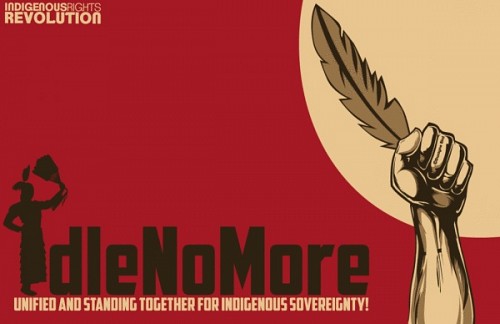Change the conversation, support rabble.ca today.
Apparently decolonization happens when you are busy taking other stands.
As activists in Canada this fall struggled to defeat a tuition hike in Quebec, to defy anti-union legislation in Ontario, and to block pipeline and other colonial and capitalist development on Indigenous territories in the West, four women from Saskatchewan — Nina Wilson, Sylvia McAdam, Jessica Gordon, and Sheelah McLean — sparked the grassroots Idle No More movement to raise awareness about the potentially devastating effects of Bill C-45 for both Indigenous and non-Indigenous peoples in the territories today known as Canada.
In only a few short months, the Idle No More movement (which is taking a variety of forms from organized teach-ins, protests, and rallies to blockades, flash-mobs, and consciousness-raising projects/art etc.) has spread throughout much of Canada as well as internationally to force “decolonization” into the public spotlight. The Idle No More movement’s potential for radical change is still unclear; however, as a mass outpouring of frustration by many Indigenous peoples and their non-Indigenous supporters it is worthy of greater attention and critical debate on the Canadian left.
Those involved in Idle No More can benefit from an understanding of how this new movement fits with the longer history of Indigenous resistance. An awareness of the history of Indigenous struggles can be used to develop better short-term and long-term tactics and strategies for love, solidarity, and decolonization moving forward.
Many of the grievances voiced by those involved in the Idle No More movement are not new (see the manifesto). In a recent pamphlet in support of Idle No More called “Resetting and Restoring the Relationship Between Indigenous Peoples and Canada,” Taiaiake Alfred and Tobold Rollo rightly explain how Indigenous protests, blockades, and general activism in the 1980s and early 1990s over land and sovereignty, like the Oka standoff in Kanesatake, put pressure on the Canadian state to set up the Royal Commission on Aboriginal Peoples. The authors suggest that the federal government might return to the framework for mutual respect, peace, and friendship outlined in the 1996 report of the Royal Commission on Aboriginal Peoples, including removing all restrictions on the modern treaty-making process, providing greater assistance to Indigenous Nations as they begin to assume responsibility for social, cultural, and educational services, and acknowledging its ongoing complicity in colonial and capitalist conquest. Certainly such a framework can be a tangible starting place for meaningful decolonizing discussions in the coming weeks and months.
However, it must also be recalled that Indigenous peoples’ struggles for land, dignity, and greater autonomy are not just recent developments. Indeed, Indigenous peoples have never been ‘idle’ in their resistance.
Those involved in the Idle No More movement will do well to closely examine the history of Indigenous resistance in the Americas generally and in Canada specifically. For example, the demands for land and sovereignty in the 1980s and 1990s in places like Oka and Gustafson Lake are connected to those of earlier militant struggles such as the blockade of an important gold rush trail linking Alberta to the Klondike by several hundred members of the Beaver First Nation in the late 1890s. This direct action successfully put economic pressure on the federal government to quickly extend Treaty 8 to the Beaver First Nation to end the blockade.
In terms of “Indian rights,” the struggles of the 1980s and 1990s also drew upon the activism in Canada around the 1969 White Paper and the reforming of the Indian Act in 1946 as well as earlier calls for Indigenous rights by groups such as the Nisga’a Land Committee in British Columbia in the late nineteenth and early twentieth centuries.
And while all of these movements differed in their specific demands and tactics, people today can draw on two important lessons from the long history of Indigenous struggles in Canada to inspire new forms of resistance and visions for change.
The first lesson is that reformist initiatives, while extremely significant, have generally been less successful than the direct actions such as the Beaver blockade in bringing about immediate and radical change.
The second lesson is that the Canadian state is not an ally; it will continue to safeguard capitalist accumulation and defend the legitimacy of Canada’s capitalist settler society at all costs. Thus, rights-based claims and calls for increased state funding and services for Indigenous peoples are important short-term goals but must ultimately be connected to more radical, long-term strategies for decolonization.
In the Wretched of the Earth, Frantz Fanon argues that “each generation must, out of relative obscurity, discover its mission, fulfill it, or betray it.” What Idle No More will become is hard to tell at the current conjuncture.
What is clear is that it is time for the current generation of Indigenous and non-Indigenous peoples to build on the lessons of past struggles to forge new relations and, working side by side, to decide what our mission is and how we can bring it about together to establish peace and friendship through decolonization.
Sean Carleton is a PhD Candidate in the Frost Centre for Canadian and Indigenous Studies at Trent University. He currently lives on the traditional territory of the Lenape people (Manhattan, New York City).
This article was originally published in Canadian Dimension.



